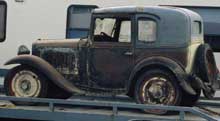New Year’s Day 1929 found Sir Herbert and Mrs. Austin aboard the RMS Berengaria bound for New York. Among their baggage were four Austin Sevens. Sir Herbert hoped to find a franchisee for his minicar in the New World. After returning home he heard from some bankers in western Pennsylvania, and in due course the American Austin Car Company was established at Butler.
The American directors of the new firm felt the English Austin needed some flashier lines, and looked to Detroit for inspiration. Hayes Body Company submitted proposals by Alexis de Sakhnoffsky, a Russian count who had become their art director. Spiffy little coupes and roadsters were placed into production and advertised in a brochure illustrated by Esquire artist Lawrence Fellows. Borrowing the “sweep panel” associated with Duesenberg, Sakhnoffsky made the cars jaunty, and they looked as just as attractive from the rear, and the driving position, while bit cramped, was nicely appointed. A delivery van was also offered, with prices starting at $445, which, inauspciously, would also buy a full-size Model A Ford.
The car’s engine was a mirror image of the British version, and the car took a stylish Bantam rooster as its mascot, proudly displayed on the radiator cap. Reportedly, it was the first American car to locate the battery under the hood. Alas, despite a reputed 184,000 orders, only 8,558 cars were delivered by the end of 1930. Sales in 1931 were only 1,279, and the company went into receivership. Roy Evans, the charismatic Florida dealer, took charge, selling most of the accumulated inventory for prices as low as $275. Evans reorganized the company into the American Bantam Car Company, had Sakhnoffsky update the styling and borrowed some money. The new Bantam car entered production late in mid-1937. “A Better Buy” the company called it.
In addition to the familiar roadster and coupe, models included a pickup, station wagon and panel delivery trucks both regular and posh “Boulevard” style. A Speedster model had seating for four, later cars moving the headlamps out to the fenders. Prices ranged from $399 to $565 in 1939, but customers still weren’t buying. Only about 6,000 Bantams were built through 1940. By that time, the company was competing in the “Jeepstakes,” the Army’s campaign for a 4×4 utility vehicle. Although the Bantam “Jeep” (though it wasn’t called that) was attractive to the Quartermaster Corps, Bantam didn’t have the capability to build in quantity, so Willys and Ford got the contracts. Bantam, however, was given a consolation award to build trailers for the armed services, which they did throughout World War II and in the civilian market until 1956.
With production so low, you’d think they’d be rare, but unrestored cars keep turning up at Hershey.

